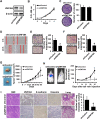ZNF384-ZEB1 feedback loop regulates breast cancer metastasis
- PMID: 36100877
- PMCID: PMC9469556
- DOI: 10.1186/s10020-022-00541-1
ZNF384-ZEB1 feedback loop regulates breast cancer metastasis
Abstract
Background: Breast cancer has become the most frequently diagnosed cancer worldwide. Increasing evidence indicated that zinc finger proteins (ZNFs), the largest family of transcription factors, contribute to cancer development and progression. Although ZNF384 is overexpressed in several types of human cancer, the role of ZNF384 in breast cancer remains unknown. Therefore, our research focused on ZNF384 regulation of the malignant phenotype of breast cancer and the underlying molecular mechanisms.
Methods: CCK-8 and colony formation assays were used to evaluate cell proliferation. Transwell and scratch assays were used to evaluate the cell migration and invasion. Chromatin immunoprecipitation (ChIP)-qPCR and luciferase reporter assays were used to confirm the target relationship between ZNF384 and zinc finger E-box binding homeobox 1 (ZEB1). Xenografts were used to monitor the targets in vivo effects.
Results: We noted that ZNF384 was significantly overexpressed in breast cancer and highlighted the oncogenic mechanism of ZNF384. ZNF384 transactivated ZEB1 expression and induced an epithelial and mesenchymal-like phenotype, resulting in breast cancer metastasis. Furthermore, ZNF384 may be a target of miR-485-5p, and ZEB1 can up-regulate ZNF384 expression by repressing miR-485-5p expression. Together, we unveiled a feedback loop of ZNF384-ZEB1 in breast cancer metastasis.
Conclusions: The findings suggest that ZNF384 can serve as a prognostic factor and a therapeutic target for breast cancer patients.
Keywords: Breast cancer; Epithelial to mesenchymal transition; Metastasis; ZEB1; ZNF384; miR-485.
© 2022. The Author(s).
Conflict of interest statement
The authors have no competing interest.
Figures







Similar articles
-
UBE2C, Directly Targeted by miR-548e-5p, Increases the Cellular Growth and Invasive Abilities of Cancer Cells Interacting with the EMT Marker Protein Zinc Finger E-box Binding Homeobox 1/2 in NSCLC.Theranostics. 2019 Mar 17;9(7):2036-2055. doi: 10.7150/thno.32738. eCollection 2019. Theranostics. 2019. Retraction in: Theranostics. 2020 Jul 25;10(21):9619. doi: 10.7150/thno.50254. PMID: 31037155 Free PMC article. Retracted.
-
Copy number gain of ZEB1 mediates a double-negative feedback loop with miR-33a-5p that regulates EMT and bone metastasis of prostate cancer dependent on TGF-β signaling.Theranostics. 2019 Aug 14;9(21):6063-6079. doi: 10.7150/thno.36735. eCollection 2019. Theranostics. 2019. PMID: 31534537 Free PMC article.
-
LncRNA ADPGK-AS1 promotes pancreatic cancer progression through activating ZEB1-mediated epithelial-mesenchymal transition.Cancer Biol Ther. 2018 Jul 3;19(7):573-583. doi: 10.1080/15384047.2018.1423912. Epub 2018 Apr 19. Cancer Biol Ther. 2018. PMID: 29667486 Free PMC article.
-
Oncogenic functions of the EMT-related transcription factor ZEB1 in breast cancer.J Transl Med. 2020 Feb 3;18(1):51. doi: 10.1186/s12967-020-02240-z. J Transl Med. 2020. PMID: 32014049 Free PMC article. Review.
-
Metastasis and chemoresistance in breast cancer: Crucial function of ZEB1/2 proteins.Pathol Res Pract. 2025 Mar;267:155838. doi: 10.1016/j.prp.2025.155838. Epub 2025 Feb 11. Pathol Res Pract. 2025. PMID: 39954369 Review.
Cited by
-
RGS1 and CREB5 are direct and common transcriptional targets of ZNF384-fusion proteins.Cancer Med. 2024 Jul;13(14):e7471. doi: 10.1002/cam4.7471. Cancer Med. 2024. PMID: 39015025 Free PMC article.
-
CBX4/miR-190 regulatory loop inhibits lung cancer metastasis.Thorac Cancer. 2024 Sep;15(26):1889-1896. doi: 10.1111/1759-7714.15415. Epub 2024 Aug 4. Thorac Cancer. 2024. PMID: 39098997 Free PMC article.
-
The pivotal role of ZNF384: driving the malignant behavior of serous ovarian cancer cells via the LIN28B/UBD axis.Cell Biol Toxicol. 2024 Nov 19;40(1):100. doi: 10.1007/s10565-024-09938-6. Cell Biol Toxicol. 2024. PMID: 39562372 Free PMC article.
-
Cancer-associated fibroblasts-secreted lactate promotes RNA polymerase III subunit G-mediated epithelial-mesenchymal transition in non-small cell lung cancer by increasing m6A modification of zinc finger protein 384.J Cell Commun Signal. 2025 Jul 25;19(3):e70037. doi: 10.1002/ccs3.70037. eCollection 2025 Sep. J Cell Commun Signal. 2025. PMID: 40717692 Free PMC article.
-
Integrated Network Analysis Decipher ZNF384-Related miR-20b-5p and miR-424-5p in Colon Adenocarcinoma.Cancer Rep (Hoboken). 2025 May;8(5):e70233. doi: 10.1002/cnr2.70233. Cancer Rep (Hoboken). 2025. PMID: 40405535 Free PMC article.
References
-
- Addison JB, Koontz C, Fugett JH, Creighton CJ, Chen D, Farrugia MK, Padon RR, Voronkova MA, McLaughlin SL, Livengood RH, Lin CC, Ruppert JM, Pugacheva EN, Ivanov AV. KAP1 promotes proliferation and metastatic progression of breast cancer cells. Can Res. 2015;75:344–355. doi: 10.1158/0008-5472.CAN-14-1561. - DOI - PMC - PubMed
Publication types
MeSH terms
Substances
LinkOut - more resources
Full Text Sources
Other Literature Sources
Medical
Research Materials

